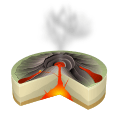Meiji Seamount
| Meiji Seamount | |
|---|---|
|
Elevation of the Pacific seafloor, showing the Hawaiian-Emperor seamount chain including Meiji Seamount near top. | |
| Summit depth | approx. 2,000 m (6,562 ft) |
| Location | |
| Location | North Pacific Ocean, east of the Kamchatka Peninsula |
| Coordinates | 53°12′N 164°30′E / 53.200°N 164.500°ECoordinates: 53°12′N 164°30′E / 53.200°N 164.500°E |
| Geology | |
| Type | Guyot |
| Volcanic arc/chain | Hawaiian-Emperor seamount chain |
| Age of rock | 82 million years |
Meiji Seamount, named after Emperor Meiji, the 122nd Emperor of Japan, is the oldest seamount in the Hawaiian-Emperor seamount chain, with an estimated age of 82 million years. It lies at the northernmost end of the chain, and is perched at the outer slope of the Kuril-Kamchatka Trench. Like the rest of the Emperor seamounts, it was formed by the Hawaii hotspot volcanism, grew to become an island, and has since subsided to below sea level, all while being carried first north and now northwest by the motion of the Pacific Plate. Meiji Seamount is thus an example of a particular type of seamount known as a guyot, and some publications refer to it as Meiji Guyot.
Meiji Seamount will eventually be destroyed by subduction by the Aleutian Trench once it is carried into the trench by the ongoing plate motion, although this will not fully occur for several million more years if the current rate of motion is maintained. Although Meiji is the oldest extant seamount in the Hawaii-Emperor chain, the question of whether there were older seamounts in the chain which have already been subducted into the trench remains open, and is the subject of ongoing scientific research.
The Deep Sea Drilling Project (DSDP) Leg 19, Hole 192A, recovered 13 m (43 ft) of pillow lava from near the summit of Meiji.[1] The lavas were initially classified as alkali basalts on the basis of their mineralogy, but subsequent microprobe analyses of glass and pyroxene suggested that they are tholeiitic in origin. At least five flows were found.[2]
See also
References
- Notes
- Bibliography
- "Volcano World: The Hawaiian - Emperor Volcanic Chain". Retrieved 2007-03-25.
- Scholl, David W.; Creager, Joe S.; Boyce, Robert E.; Echols, Ronald J.; Fullam, Timothy J.; Grow, John A.; Koizumi, Itaru; Lee, Homa J.; Ling, Hsin Yi; Supko, Peter R.; Worsley, Thomas R. (1973). "Site 192: Meiji Seamount" (PDF). Deep Sea Drilling Project Initial Reports. 19: 463–533. doi:10.2973/dsdp.proc.19.111.1973.
- Dalrymple, G. Brent; Lanphere, Marvin A.; Natland, James H. (1980). "K-Ar Minimum Age for Meiji Guyot, Emperor Seamount Chain" (PDF). Deep Sea Drilling Project Initial Reports. 55: 677–683. doi:10.2973/dsdp.proc.55.129.1980.
- Scholl, D. W.; Rea, D. K. (2002). "Estimating the Age of the Hawaiian Hotspot". American Geophysical Union. 61: 05. Bibcode:2002AGUFM.T61C..05S.
- Regelous, M.; Hofmann, A. W.; Abouchami, W.; Galer, S. J. G. (2003). "Geochemistry of Lavas from the Emperor Seamounts, and the Geochemical Evolution of Hawaiian Magmatism from 85 to 42 Ma". Journal of Petrology. Max-Planck Institute for Chemie, Abteilung Geochemie, Post 3060, 55020 Mainz, Germany: Oxford University Press. 44 (1): 113–140. doi:10.1093/petrology/44.1.113.
- Norton, Ian O. (2006). "Speculations on tectonic origin of the Hawaii hotspot". Mantleplumes.org. Retrieved 2014-08-08.
- Shapiro, M. N.; Soloviev, A. V.; Ledneva, G. V. (2006). "Did Emperor seamounts subduct?". Mantleplumes.org. Retrieved 2014-08-08.

